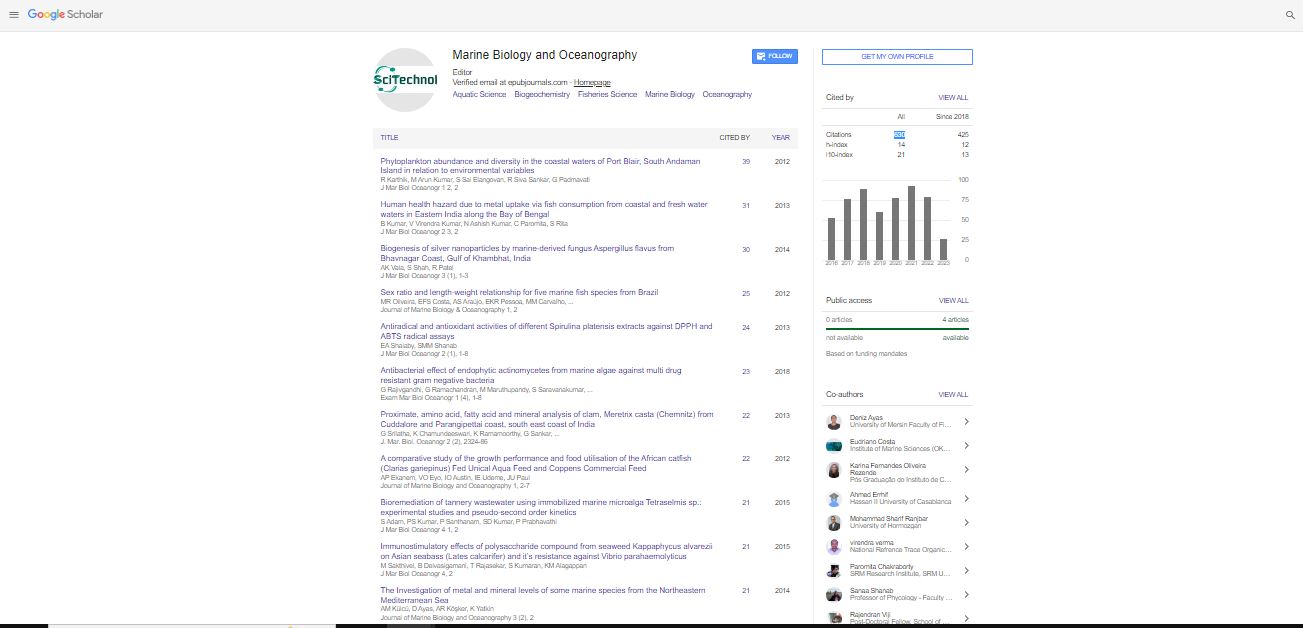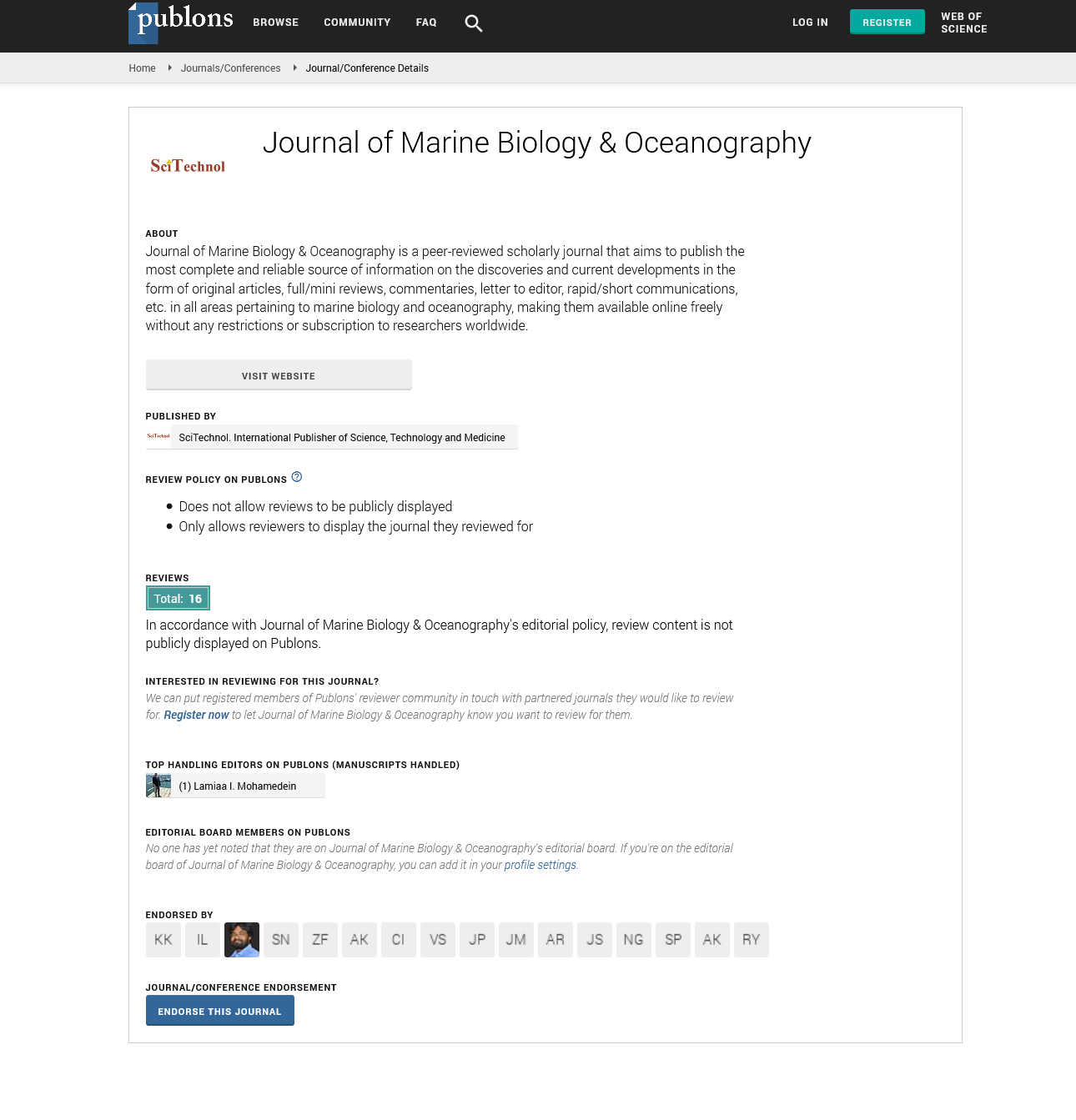Opinion Article, J Mar Biol Oceanogr Vol: 12 Issue: 1
Effect of Organic and Inorganic Contaminants on Aquatic Ecosystem
Yang Lin*
Department of Environmental Science, Zhejiang University, Hangzhou, China
*Corresponding Author: Yang Lin
Department of Environmental Science, Zhejiang
University, Hangzhou, China
E-mail: yanglin@zju.cn
Received date: 14-Feb-2023, Manuscript No. JMBO-23-91850;
Editor assigned date: 16-Feb-2023, PreQC No JMBO-23-91850 (PQ);
Reviewed date: 03-Mar-2023, QC No. JMBO-23-91850;
Revised date: 10-Mar-2023, Manuscript No. JMBO-23-91850 (R);
Published date: 20-Mar-2023 DOI: 10.4172/2324-8661.1000250.
Citation: Lin Y (2023) Effect of Organic and Inorganic Contaminants on Aquatic Ecosystem. J Mar Biol Oceanogr 12:1.
Description
The balance of aquatic ecosystems and human health may be threatened by the release of contaminants into the environment, some of which are harmful and serve as major reservoirs in aquatic ecosystems. Industrial sources, agricultural sources, home sources, and natural sources direct or indirect, specific or diffuse all contribute to these contaminants. The main types of pollutants that enter the aquatic environment and their sources are either inorganic pollutants, which can be represented by metal compounds, nitrogenous materials, and phosphorus, or organic pollutants, which are primarily represented by polycyclic aromatic hydrocarbons, pesticides, drugs, dioxins, chlorophenols, and phthalates. Among the most significant Persistent Organic Pollutants (POPs), Organo Chlorine Pesticides (OCPs) and Polychlorinated Biphenyls (PCBs) are well known for their chronic toxicity, persistence, and bioaccumulation. The main sources of organic contaminants in freshwater are home sewage discharges (even after treatment) and some industries, such as food processing. Organic compounds can be either natural (in which case they typically decay) or artificial (in which case they can often be degraded by microorganisms that have adapted to utilizing them).
Heavy metals, inorganic anions, and radioactive substances make up the majority of the Inorganic compounds found in aquatic settings. It is important to remember that in chemical toxicology, the concentration of a chemical, not its presence. Thus, substances that are designated as environmental risks, such as As, Al, Sb, Ba, Be, Cd, Co, Cu, Ce, Pb, Mo, Hg, Zn, etc., work as nutrients in trace amounts and are crucial for the normal growth and development of both animals and humans. Additionally, these heavy metals enter humans through the food chain, leading to issues with public health. Fish waste, uneaten food, and dead animals which often carry antibiotics are the three main organic pollution sources in marine aquaculture farms, which are more or less invasive constructions that physically transform and alter the marine environment. Their breakdown worsens the quality of the water and sediment and raises the biological demand for oxygen. Chemically active substances that are released from industry are considered organic pollutants. These could be carried by water currents from their source and end up in seawater. These chemically active compounds include micro plastics, the leaching of chemical additives, and persistent organic pollutants. They are ingested by green algae and may disrupt photosynthesis processes. They also have an impact on marine invertebrates and vertebrates through prey transfer. Ingestion, retention, and egestion are the three major physical interactions of organic contaminants with marine biota. These processes can impair the nutritional health of organisms. They pave the way for a reduction in structural growth, maturity, .and reproduction in many marine biota. Persistent organic pollutants, chemical additive leaching, and micro-plastics are examples of chemically active substances. Green algae consume them, which may prevent normal photosynthesis from taking place. They also have an effect on marine vertebrates and invertebrates by acting as prey.
Inorganic minerals and chemical compounds
From municipal, industrial, and urban runoffs, a wide range of inorganic pollutants find their way into freshwater. In addition to harming or killing fish and other aquatic life, these contaminants (which include compounds of As, Ca, Cd, F, Hg, Na, Pb, etc.) also make water unsafe for drinking or for industrial use. The presence of mercury in water serves as a notable example. In bottom muds, anaerobic bacteria transform inorganic mercury into methyl mercury (CH3Hg+), which can kill living things.
Conclusion
The aquatic environment is impacted by contaminants in several ways. While many pollutants, such as organic compounds N and P, may be advantageous at low concentrations, they can have a negative impact on the ecology of the system at large concentrations. Nitrate in excess might be particularly dangerous for infants. Since many of the harmful contaminants in effluents are synthetic, they are difficult to naturally biodegrade. In order to protect public health and maintain the ecosystem, it is important to measure and regulate the quality of the water. The government must develop plans for the secure disposal of home sewage and industrial waste in order to protect aquatic bodies.
 Spanish
Spanish  Chinese
Chinese  Russian
Russian  German
German  French
French  Japanese
Japanese  Portuguese
Portuguese  Hindi
Hindi 
